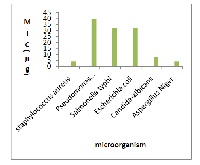Chemical composition and antimicrobial of essential oil from Artemisia Lehmanniana
Keywords:
Artemisia Lehmanniana, Essential oil, chemical composition, 1, 8- Cineole, antimicrobial, Ager Dilution, Staphylococcus aureusAbstract
The plants of A.Lehmanniana were gathered in May 2009 from the heights of 2300 m of Taftan Mountain located in Baluchestan. Its essential oil was extracted with an outcome of 1.34%w/w, using hydro distillation method. Then, using GC/MS technique, it was analyzed and 54components were recognized that constituted 96.61%of the whole essential oil. The components that had the highest percentage were as Follow: 1, 8- Cineole (22.06%), (z)-2-Nonenal (12.11%), Nonaconsane (8.97%), α-Terpineol (5.90%), 4-Terpineol (5.07%), Camphor (4.19%) and unknown compound (4. 41%). Antimicrobial effects of this essential oil were exactly estimated and examined in Laboratory. Its sensitiveness (Minimal inhibition Concentration) to mentioned-micro-organisms in the following: Staphylococcus aureus (4μg/ml), Salmonella typhi (32μg/ml), Escherichia coli (32μg/ml), Candida albicans (8μg/ml), Aspergillus Niger (4 μg/ml), showed that the highest was recognized by comparing with standard samples with the way of dilution and minimum controlling concentration was calculated. As the results revealed, the micro-organism of Pseudomonas aeruginosa could be controlled in higher concentrations.
References
. Ayfer D, Turgayo. antimicrobial activities of various medicinal and commercial plant extracts.Turk.J.Biol.
; 27:157-162.
. Burts S. Essential oils: their antimicrobial properties and potential applications in Foods-a review.Int.J.Food.Microboil. 2004; 94:223-253 .
. Abdelwahed A,Hayder N,Kilani S,Mahmoud A, chibani J,Hammami M. Chemical composition andantimicrobial activity of essential oils from Tunisianpituranthos toruosusCoss) Maire.Flavour.Frag.J. 2006; 21:120-133. extracts.Turk.J.Biol. 2003; 27:157-162.
. Fazly Bs ,Harizdeh G. Screening of Iranian plants for antimicrobial activity ,pharmaceutical Biology. 2003;41:573-58.
. Linda M, Kelly M, Jacobs R and.Appelbaum peter C. journal of Antimicrobial Chemotherapy. 1999;43:707-709.
. Mozaffarian V. A Dictionary of Iranian Plant Names. Farhang Moaser. 2007. Tehran.
. Van Den Dool H and Kratz PD. A generalization of the retention index system including linear temperature
programmed gas-liquid partition chromatography. J. Chromatogr. 1963; 11:463-471 .
. Adams RP. Identification of Essential Oil Components by Gas Chromatography/Mass Spectroscopy. Allured Publ. Corp. 1995;Carol Stream, IL .
. National Committee for Clinical Laboratory Standards. Performance Standards for Antimicrobial Susceptibility Testing· Eighth Informational Supplement: Approved Standard M100 S8. NCCLS, Wayne, PA. 1998.
. Jones RN. Preliminary interpretive criteria for in vitro susceptibility testing of CP-99,219 by dilution and disc
diffusion methods. Diagnostic Microbiology and Infectious Disease. 1994; 20: 167-70



